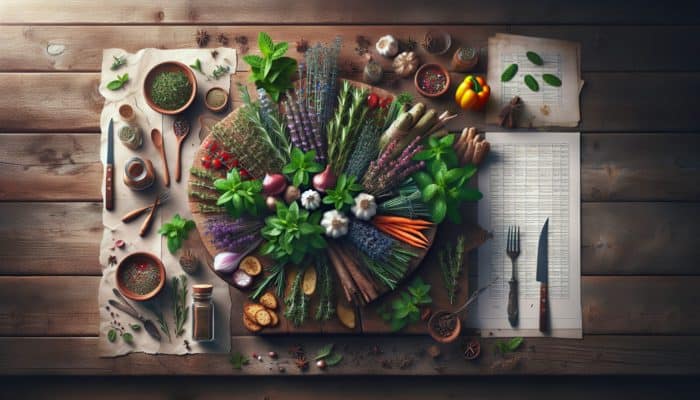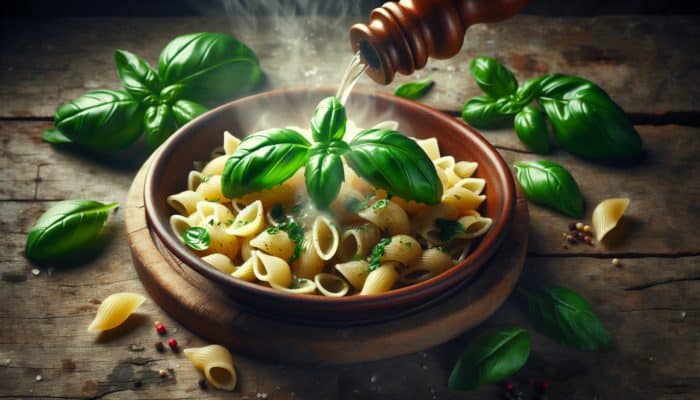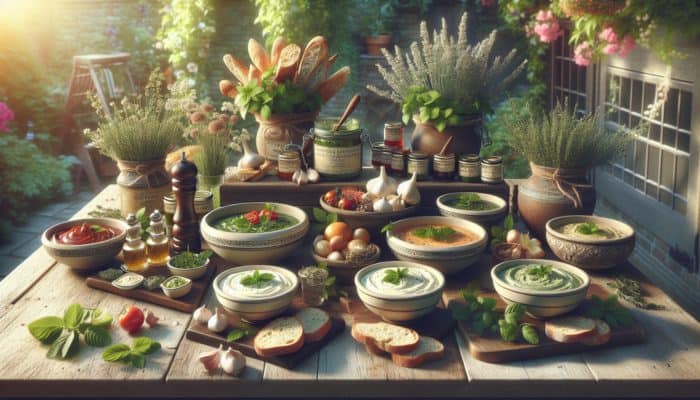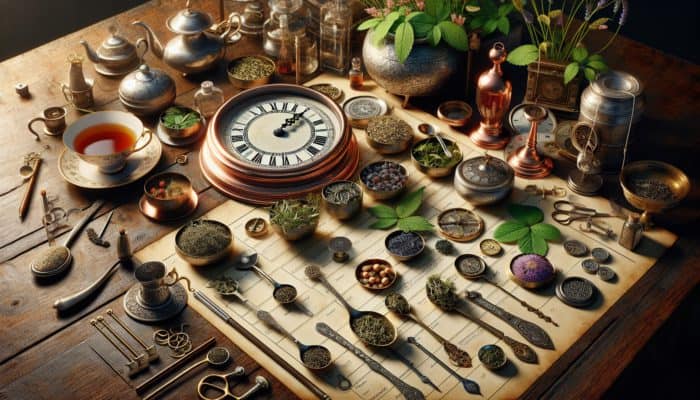Exploring the Rich Heritage of Herbal Blends in the UK
Blending Herbs for Specific Outcomes: The vibrant history of herbal usage in the UK is intricately interwoven with centuries of tradition, highlighting the profound relationship between nature and human creativity in the utilisation of plants. The historical importance of herbs reaches far beyond their culinary applications, serving as a testament to the wisdom of ancient herbalists and the practices of modern holistic practitioners. The art of blending herbs for specific outcomes has consistently provided remedies aimed at alleviating physical ailments, addressing emotional challenges, and fulfilling spiritual needs, showcasing the versatility and importance of these natural ingredients in our lives.
Herbs have long been a cornerstone of British folk medicine, frequently employed to alleviate common ailments. Notably, thyme has been esteemed for its antiseptic properties, while chamomile has been brewed to ease digestive discomfort and foster relaxation. This enduring connection with nature has sparked a contemporary revival of interest in herbal blends, as modern enthusiasts aim to honour traditional practices while adapting them for contemporary lifestyles, bridging the gap between past and present in the realm of natural remedies.
At the heart of the British garden, various herbs have emerged as staples, each showcasing unique characteristics and benefits. Herbs such as rosemary, mint, and sage thrive in the UK’s temperate climate, providing an abundance of flavours and therapeutic qualities. Rosemary, renowned for its robust aroma, is celebrated not only as a culinary favourite but also for its cognitive-enhancing properties. Mint is widely acknowledged for its ability to soothe digestive issues, making it a vital ingredient in numerous herbal blends. Sage, rich in history within both cuisine and traditional medicine, serves as a potent antioxidant, further emphasising the multifaceted benefits of these plants.
A thorough understanding of the regulatory framework surrounding herbal blends is essential for anyone interested in this field. In the UK, the use of herbs is governed by stringent regulations aimed at ensuring consumer safety and product efficacy. The Herbal Medicines Directive establishes guidelines regarding the marketing and sale of herbal products, requiring thorough assessments of quality. Additionally, many herbalists and producers pursue certification from reputable organisations, bolstering consumer confidence in their commitment to safety and efficacy.
The Historical Significance of Herbs in British Medicine

Historically, herbs have played a crucial role in the medical practices of the UK. Long before the emergence of modern medicine, communities relied heavily on the natural world for their healing needs. Ancient texts indicate that herbs were commonly prescribed for various ailments, with significant references made to plants such as nettle and willow bark. The herbal knowledge passed down through generations not only enriched local cultures but also laid the foundation for contemporary herbalism, bridging the wisdom of the past with modern practices.
During the medieval period, monasteries emerged as centres of herbal knowledge, where monks cultivated gardens abundant with medicinal herbs. This tradition paved the way for the establishment of herbal apothecaries during the Renaissance. Today, the legacy of these historical practices endures, as herbalism gains recognition not merely as an alternative form of medicine but as a respected and legitimate field that embodies the wisdom of ages past.
The use of herbs in British cuisine is also deeply rooted in history. Traditional dishes frequently incorporated local herbs, enhancing both flavour and health benefits. A prime example is the renowned English herb blend, ‘Herbes de Provence’, which showcases the quintessential flavours of the region. This blend, rich in thyme, sage, and rosemary, not only adds depth to culinary creations but also carries the nutritional benefits associated with these herbs.
As interest in holistic health continues to flourish, many individuals are returning to these traditional remedies, experimenting with blending herbs to achieve specific outcomes and address modern health concerns. The resurgence of herbalism emphasises the importance of understanding historical uses, enabling us to reconnect with our roots while innovating to meet contemporary needs.
Exploring Popular Herbs Found in UK Gardens
Across the UK, gardens are enriched with a plethora of herbs, each possessing unique traits that contribute to their widespread appeal. The cultivation of herbs such as basil, chives, and coriander has become increasingly common, with home gardeners embracing their versatility. Basil is celebrated not only for its aromatic flavour but also for its anti-inflammatory properties, making it a stellar choice for wellness-focused blends.
Often overlooked, chives are an excellent addition to both culinary and health applications. Packed with vitamins A and C, chives can be blended with other herbs to create vibrant, health-promoting concoctions. Coriander, renowned for its distinctive flavour, also possesses antibacterial properties, making it a valuable herb for individuals seeking to enhance their immune response.
The adaptability of these herbs extends to their cultivation methods. Many can flourish in pots or compact garden beds, making them accessible for novice gardeners. This ease of growth encourages a greater appreciation for herbs, fostering a culture of experimentation with blending herbs for specific outcomes in both health and culinary applications.
The integration of herbs into daily life in the UK has also spurred educational initiatives aimed at teaching individuals how to cultivate and utilise these plants effectively. Workshops and community gardens are emerging, inviting people to explore the joys of herb gardening. These initiatives not only promote sustainable practices but also encourage a deeper understanding of the properties and benefits of herbs.
Understanding Regulatory Guidelines for Herbal Products
Navigating the regulatory landscape surrounding herbal blends in the UK is vital for anyone with an interest in this area. The regulation of herbal products is primarily governed by the Herbal Medicines Directive, which ensures that these offerings meet rigorous safety and quality standards. This directive requires that herbal remedies undergo thorough assessments, emphasising the importance of transparency and consumer protection within the industry.
All herbal products marketed in the UK must either be licensed as traditional herbal medicine or exempt from licensing if utilised as food supplements. This distinction is crucial for both producers and consumers, as it establishes a framework within which herbal products can be safely and effectively marketed.
Moreover, many herbalists pursue certification from recognised bodies, such as the National Institute of Medical Herbalists. This certification not only reassures consumers about the quality of the products they purchase but also builds trust within the herbal community. It signifies adherence to best practices in herbal medicine, including ethical sourcing and sustainable cultivation methods.
As the market for herbal products continues to expand, awareness of these regulatory considerations becomes increasingly important. Consumers are encouraged to seek certifications and educate themselves about the herbal remedies they choose, empowering them to make informed decisions. This ensures that their exploration of blending herbs for specific outcomes is both safe and beneficial.
Crafting Herbal Blends for Enhanced Health and Wellness

The practice of blending herbs for specific outcomes has gained significant traction in the UK as a holistic approach to health and wellness. This artful combination of nature’s bounty aims to harness the therapeutic properties of various herbs, creating potent blends tailored to individual health needs and personal preferences.
The increasing trend towards natural remedies and self-care has inspired many to explore the benefits of herbal blends. Not only do these blends offer a myriad of health benefits, but they also provide a delightful sensory experience, appealing to the senses of taste, smell, and even visual aesthetics. As individuals seek to enhance their overall well-being, the blending of herbs serves as a creative outlet for crafting personalised wellness solutions that resonate with their unique lifestyles.
Powerful Herbs for Immune Support
Immune support has become a key focus for many individuals seeking to enhance their health, particularly during seasonal illnesses. Certain UK herbs are well-regarded for their immune-boosting properties, making them ideal candidates for blending into herbal remedies. For example, elderflower has long been celebrated for its ability to alleviate cold symptoms and reduce inflammation, attributed to its high antioxidant content.
When combined with echinacea, another herb renowned for its immune-boosting effects, this pairing creates a potent tonic. Echinacea, often utilised during cold and flu season, works synergistically with elderflower to provide comprehensive support. The result is a delightful herbal tea that not only offers comforting warmth but also strengthens the body’s natural defences.
Another noteworthy herb is garlic, renowned for its antimicrobial properties. It can be effectively blended with other herbs, such as thyme and oregano, to create a robust, immune-supportive infusion. This blend not only enhances immunity but also adds depth to culinary creations, showcasing the versatility of herbs in both health and flavour.
The preparation of these blends can take various forms, including teas, tinctures, or syrups. For those eager to incorporate immune-supporting herbs into their daily routine, a simple infusion of elderflower, echinacea, and garlic can be easily prepared. The process is straightforward: steep the dried herbs in hot water, allowing the flavours and beneficial compounds to be extracted effectively.
Engaging in the practice of blending herbs for specific outcomes not only offers health benefits but also fosters a sense of empowerment and well-being. As individuals take charge of their wellness journeys, they can explore and experiment with various combinations, discovering what works best for their unique needs and preferences.
Creating Blends for Digestive Health
The significance of digestive health cannot be overstated, and many individuals in the UK are actively seeking natural methods to support their gastrointestinal well-being. Certain herbs have been proven particularly effective in promoting digestion, making them excellent choices for crafting specific blends designed to achieve this purpose. Peppermint, for instance, is widely recognised for its soothing properties that provide relief from bloating and discomfort.
When combined with ginger, known for its anti-nausea effects, this duo creates a potent digestive blend. Ginger’s warming qualities complement the cooling essence of peppermint, making this blend an ideal choice for those experiencing digestive distress. The resultant herbal tea can be enjoyed after meals, promoting a healthy digestive process and overall comfort.
Another herb worthy of consideration is fennel, often utilised to alleviate gas and cramping. By blending fennel with chamomile, which is renowned for its calming effects, one can create a gentle tea that not only soothes the stomach but also promotes relaxation. This blend is particularly beneficial for individuals who experience digestive discomfort related to stress, offering a holistic approach to overall well-being.
Creating these digestive health blends can be as simple as combining equal parts of dried herbs and steeping them in hot water. The key is to experiment with proportions until you find a flavour balance that pleases your palate and supports your health.
The incorporation of blending herbs for specific outcomes into one’s daily routine not only supports digestive health but also fosters a deeper connection with the healing properties of nature. Exploring the diverse world of herbs empowers individuals to take charge of their health, allowing for personalised wellness interventions that resonate with their specific needs.
Utilising Herbs for Stress Relief

In our fast-paced modern world, finding effective methods for stress relief has become a priority for many, and herbs can play a significant role in promoting relaxation and tranquillity. Several herbs native to the UK are well-known for their calming properties, making them ideal candidates for creating stress-relief blends. Lavender, for instance, is widely acknowledged for its ability to reduce anxiety and promote restful sleep, proving invaluable in today’s busy lifestyles.
When combined with lemon balm, known for its mood-enhancing effects, this combination creates a delightful infusion that soothes both mind and body. The calming fragrance of lavender pairs beautifully with the fresh, citrus notes of lemon balm, resulting in a fragrant tea that can be enjoyed throughout the day. This blend is particularly beneficial in the evenings, preparing the body for restful sleep and relaxation.
Another herb to consider is passionflower, traditionally used for its anxiolytic properties. When paired with chamomile, this duo creates a relaxing tea that can help ease tension and foster calmness. The floral notes of both herbs combine to create a pleasant and soothing drink, perfect for unwinding after a long day and promoting a sense of calm and peace.
Crafting these stress-relief blends allows individuals to tailor their herbal experiences. A simple recipe could involve equal parts of lavender, lemon balm, and chamomile, steeped in hot water to extract the beneficial compounds and create a comforting infusion.
The act of blending herbs for specific outcomes fosters mindfulness, encouraging individuals to take a moment for self-care. As one savours the soothing aromas and flavours of these calming blends, it transforms into a ritual that promotes relaxation and peace in an otherwise hectic world.
Exploring Culinary Herb Blends
The culinary landscape of the UK is rich in opportunities to explore the art of blending herbs for specific outcomes. Herb blends not only elevate the flavour profiles of traditional British dishes but also enhance nutritional value, enriching meals with diverse health benefits.
As home cooks and professional chefs alike strive to innovate, the blending of herbs presents a creative outlet for experimentation with flavours, allowing for personalised culinary experiences that celebrate the richness of local produce and the art of cooking.
Enhancing Traditional Flavour Profiles with Herb Blends
Blending herbs in the kitchen facilitates the creation of unique flavour profiles that elevate traditional British dishes. For instance, the classic combination of parsley, sage, rosemary, and thyme has been utilised for centuries to season meats, stews, and root vegetables. This blend, often referred to as the ‘British four’, provides a fragrant and robust foundation that enhances the natural flavours of the ingredients, transforming everyday meals into culinary delights.
The key to successful flavour blending lies in understanding the individual characteristics of each herb. For example, the strong, pine-like aroma of rosemary pairs beautifully with the earthy notes of sage, while parsley contributes a fresh, bright element. This harmonious combination creates a well-rounded seasoning that can elevate even the simplest dishes into masterpieces of flavour and nutrition.
Another popular blend is the ‘Herbes de Provence’, which combines a variety of herbs, including thyme, oregano, and marjoram. This blend is perfect for enhancing roasted vegetables and meats, infusing them with a delightful Mediterranean flair. The versatility of this blend makes it a staple in many kitchens, allowing for endless possibilities in meal preparation and flavour exploration.
Experimenting with herb blends is not limited to savoury dishes. Sweet dishes can also benefit from intriguing flavour combinations that herbs can provide. For instance, blending mint with chocolate can create a refreshing dessert that tantalises the taste buds and offers a unique culinary experience.
The practice of blending herbs for specific outcomes in culinary applications not only enhances meals but also encourages creativity in the kitchen. As individuals explore different combinations, they discover new dimensions of flavour that elevate their culinary creations and enrich their dining experiences.
Creating Seasonal Herb Blends
Crafting seasonal herb blends is an exciting way to celebrate the bounty of the UK’s changing landscape. Each season brings forth a unique array of herbs, allowing for the development of blends that reflect the essence of the time of year and the flavours of the season.
In spring, vibrant herbs such as chives, parsley, and dill emerge, making them perfect candidates for a fresh spring herb blend. This blend can be utilised to enhance salads and dressings, adding a burst of flavour that complements the lighter fare of the season, celebrating the freshness of spring produce.
As summer arrives, basil, mint, and coriander come to the forefront. A refreshing summer herb blend can be crafted from these fragrant herbs, ideal for use in salads, salsas, and light pasta dishes. The bright, aromatic flavours of these herbs evoke the essence of summer dining, making every meal feel like a celebration of the season’s bounty.
Autumn invites the use of heartier herbs such as thyme, sage, and rosemary, which can be blended to enhance roasted root vegetables and hearty stews. This comforting blend embodies the warmth of the season, providing a nourishing experience as the weather turns cooler and the desire for wholesome meals grows.
During winter, herbs like bay leaf and winter savoury become prominent, perfect for infusing flavour into slow-cooked dishes and warming soups. By creating seasonal blends, cooks can capitalise on the herbs that are at their peak while also embracing the evolving culinary landscape of the seasons.
The exploration of blending herbs for specific outcomes in a seasonal context encourages a deeper connection with nature and the cycles of life. It invites individuals to celebrate the rhythms of the earth while fostering creativity in the kitchen, making culinary experiences more meaningful and enriching.
Pairing Herbs with Local Ingredients for Enhanced Flavours
Incorporating local produce into herb blends not only celebrates regional flavours but also promotes sustainability and supports local farmers. The UK’s rich agricultural diversity offers ample opportunities for pairing herbs with seasonal ingredients, creating dishes that are both delicious and environmentally friendly.
For instance, pairing fresh dill with locally sourced salmon can create a delightful dish that highlights the flavours of both the herb and the fish. Dill, with its anise-like notes, complements the richness of the salmon beautifully, creating a harmonious balance. This combination can be further enhanced by incorporating lemon juice, which brightens the overall flavour profile and adds a zesty twist.
Similarly, pairing rosemary with lamb is a classic British combination that showcases the distinctive characteristics of both ingredients. The robust flavour of rosemary complements the tender richness of lamb, resulting in a mouthwatering experience deeply rooted in tradition and culinary practice.
When crafting herb blends, it is essential to consider the seasonality of both herbs and local ingredients. By doing so, cooks can ensure that they are using the freshest produce available, significantly enhancing the overall quality of their dishes. This approach not only results in superior flavour but also promotes a greater appreciation for the local food landscape and the communities that sustain it.
The practice of blending herbs for specific outcomes in conjunction with local ingredients fosters creativity and innovation in the kitchen. As individuals experiment with various combinations, they discover new ways to celebrate the flavours of their region, creating dishes that reflect their culinary heritage and personal tastes.
Preserving Herb Blends for Year-Round Enjoyment
Preserving herb blends is an essential skill for anyone looking to enjoy the flavours of their garden throughout the year. Utilising methods such as drying and freezing helps maintain the potency and aroma of herbs, allowing for versatility in culinary applications and ensuring that these flavours are always at hand.
Drying herbs is a straightforward process that requires minimal effort and can be done at home. By hanging bundles of herbs in a cool, dark place, they can retain their flavour and aroma effectively. Once dried, herbs can be crumbled and stored in airtight containers, ready for use in cooking or as part of a herbal blend, ensuring that their benefits are accessible year-round.
Freezing herbs presents another effective preservation method. By chopping fresh herbs and placing them in ice cube trays with a small amount of oil or water, individuals can create flavour-packed cubes that can be easily added to soups, stews, or sauces. This method preserves the vibrant colour and taste of the herbs, ensuring that they remain a staple in the kitchen, even in the off-season.
The act of blending herbs for specific outcomes extends beyond the initial creation of the blend; it encompasses the entire journey, from garden to kitchen. By mastering the art of harvesting and storing herbs, individuals can enjoy the fruits of their labour throughout the year, promoting a sustainable and satisfying approach to cooking and wellness.
As individuals embrace the art of preserving herb blends, they cultivate a deeper appreciation for the natural world. This practice encourages mindfulness and sustainability, promoting a lifestyle that values the bounty of the earth and the flavours it provides.
Creating Herb Blends for Special Dietary Needs
The rise of specialised diets has led to an increased interest in creating herb blends that cater to various nutritional needs. Whether it’s vegan, gluten-free, or low-sodium options, the versatility of herbs provides a wealth of opportunities for crafting blends that align with specific dietary restrictions and preferences.
For those following a vegan diet, incorporating herbs such as nutritional yeast, garlic, and smoked paprika can create flavorful blends that enhance dishes without the use of animal products. This combination can be used to season vegetables, grains, or legumes, providing depth and richness to meals while adhering to vegan principles.
Individuals on a gluten-free diet can also benefit from the thoughtful use of herbs in their cooking. By creating herb blends that combine thyme, oregano, and basil, individuals can enhance the flavours of gluten-free pasta dishes or grain salads without compromising taste, making meals more enjoyable and satisfying.
Low-sodium diets can be effectively supported through the use of herbs that provide natural flavour without the need for added salt. Herbs such as dill, coriander, and parsley can be blended to create seasoning mixes that add zest to dishes, all while promoting heart health and wellness.
The art of blending herbs to achieve specific outcomes within the context of special diets promotes inclusivity in culinary experiences. By exploring various combinations, individuals can create meals that not only cater to their dietary needs but also celebrate the diverse flavours of herbs and the joy of cooking.
As dietary preferences continue to evolve, the practice of blending herbs offers a creative and flexible approach to cooking. It empowers individuals to explore new flavours and textures while honouring their personal health goals and dietary requirements.
Harnessing Herbs for Beauty and Skincare
The world of herbs extends far beyond culinary applications, offering a treasure trove of benefits for beauty and skincare. The practice of blending herbs for specific outcomes can lead to the creation of natural skincare products that promote healthy skin, hair, and overall well-being, utilising the potent properties of nature for aesthetic care.
Many herbs used in skincare have been celebrated for their healing properties, providing individuals with ample opportunities to harness the power of nature in their beauty routines. From soothing skin irritations to nourishing hair, the possibilities for herbal remedies are virtually endless, offering a holistic approach to beauty.
Creating Natural Skincare Blends
Natural skincare is a burgeoning trend, with many individuals eager to incorporate herbs into their beauty regimens. Herbs such as calendula, lavender, and aloe vera are widely recognised for their skin-soothing properties, making them ideal candidates for blending into skincare formulations that promote healthy and radiant skin.
Calendula, known for its anti-inflammatory effects, can be blended with coconut oil to create a nourishing balm for dry or irritated skin. This simple formulation can effectively soothe minor cuts, scrapes, and rashes, providing a natural alternative to conventional creams that may contain harsh chemicals.
Lavender, with its calming fragrance, is often utilised in skincare for its antiseptic properties. A blend of lavender essential oil with a carrier oil, such as jojoba, can create a soothing facial oil that hydrates and promotes a serene atmosphere during application, thereby enhancing the overall self-care experience.
Aloe vera is another powerhouse herb that can be blended into various skincare products. Its hydrating and healing properties make it ideal for creating gels or lotions that can be used to soothe sunburn or moisturise dry skin effectively, showcasing the versatility of herbs in beauty care.
By experimenting with blending herbs to achieve specific skincare outcomes, individuals can create personalised formulations that cater to their unique skin needs. The process not only fosters creativity but also allows individuals to connect with the healing power of nature, enhancing their beauty routines in meaningful ways.
Enhancing Hair Care with Herbal Blends
Herbs also play a vital role in hair care, with many offering benefits that promote healthy locks. Common herbs used in hair care include rosemary, nettle, and hibiscus, each contributing unique properties that can enhance hair health and vitality.
Rosemary is renowned for its ability to stimulate hair growth and improve scalp health. Blending rosemary essential oil with a carrier oil can create a nourishing hair treatment that encourages circulation and revitalises hair follicles. This blend can be massaged into the scalp, promoting relaxation while stimulating growth and enhancing overall hair health.
Nettle, often regarded as a weed, is a powerful herb for hair care. Rich in vitamins A and C, nettle can be blended into a hair rinse that helps to strengthen and nourish strands. A simple nettle infusion can be prepared by steeping dried nettle leaves in hot water, providing a nourishing treatment that can be used after shampooing to enhance hair vitality.
Hibiscus is another fantastic option for hair care, known for its ability to enhance shine and promote moisture retention. A hibiscus hair mask, created by blending dried hibiscus flowers with a carrier like coconut milk, can provide a luxurious treatment that deeply moisturises the hair, leaving it soft and radiant.
The practice of blending herbs for specific outcomes in hair care empowers individuals to embrace natural solutions for their hair concerns. As they explore different combinations, they discover ways to naturally enhance their hair’s health and appearance, fostering a holistic approach to beauty and self-care.
Creating Anti-Ageing Herbal Recipes
The quest for youthful skin has led many individuals to seek out natural anti-ageing remedies, with herbs offering a wealth of options. Certain UK herbs are renowned for their anti-ageing properties, making them ideal candidates for inclusion in skincare formulations that promote a youthful appearance and vitality.
Rose, for instance, is celebrated for its hydrating and soothing qualities. A blend of rose oil with a carrier oil can create a luxurious facial serum that hydrates and plumps the skin, reducing the appearance of fine lines. This blend not only nourishes the skin but also provides a sensory experience that enhances overall well-being, making it a delightful addition to any skincare routine.
Another herb to consider is gotu kola, known for its ability to stimulate collagen production and improve skin elasticity. By blending gotu kola extract with other hydrating ingredients, one can create a rejuvenating cream that promotes a youthful glow, effectively addressing signs of ageing.
Green tea is also renowned for its antioxidant properties, making it an excellent addition to anti-ageing formulations. A simple blend of green tea infusion with a moisturiser can provide a powerful treatment that protects the skin from environmental stressors while promoting a youthful complexion.
The art of blending herbs for specific outcomes in anti-ageing skincare allows individuals to take control of their beauty routines. By exploring these natural options, they can create personalised treatments that promote youthful, radiant skin, enhancing their overall self-care practices.
Utilising Herbal Remedies for Common Skin Conditions
Numerous herbs have long been recognised for their effectiveness in treating common skin conditions. From acne to eczema, the right blends can provide soothing relief and promote healing for various skin issues.
Tea tree oil, known for its antibacterial properties, can be blended with lavender oil to create a powerful treatment for acne-prone skin. This combination not only helps combat breakouts but also soothes inflammation, making it a valuable addition to any skincare routine aimed at maintaining clear, healthy skin.
Calendula, previously mentioned, can be used in blends targeted at eczema and other inflammatory conditions. A calendula-infused oil can be created by steeping dried petals in a carrier oil, producing a soothing remedy that can be applied directly to affected areas to alleviate discomfort and promote healing.
Aloe vera, with its hydrating and cooling properties, is ideal for sunburn relief. Blending fresh aloe vera gel with essential oils such as lavender can provide a refreshing treatment that alleviates discomfort while promoting healing, making it a must-have for summer skincare routines.
The exploration of blending herbs for specific outcomes in treating skin conditions empowers individuals to connect with nature’s healing power. By utilising these remedies, they can take charge of their skincare journey while fostering a deeper understanding of herbal medicine and its benefits.
Gardening and Growing Your Herbs
Cultivating herbs not only offers the delight of fresh flavours but also provides the satisfaction of nurturing plants. The practice of blending herbs for specific outcomes often begins in the garden, where individuals can connect with the natural world while cultivating their favourite plants and enjoying the fruits of their labour.
Understanding the best practices for growing herbs in the UK can significantly enhance the experience, enabling a fruitful harvest that can be utilised in both culinary and health applications. By embracing these practices, individuals can create a thriving herb garden that enriches their lives.
Best Practices for Successful Herb Gardens in the UK
Creating a successful herb garden in the UK requires an understanding of the climate and soil conditions that favour growth. Many herbs thrive in well-drained, fertile soil, making it essential to prepare the ground before planting. Incorporating organic matter, such as compost, can improve soil quality and promote healthy growth, ensuring that plants have the necessary nutrients to flourish.
Choosing the right location is also crucial. Most herbs prefer full sun, so selecting a spot that receives at least six hours of sunlight per day is ideal for robust growth. Container gardening is an effective way to grow herbs, offering flexibility in positioning and easier management of soil conditions, making it accessible to all gardeners.
In addition to proper planting techniques, regular watering and maintenance are key to a thriving herb garden. Herbs generally require consistent moisture, especially during dry spells. Establishing a regular watering schedule can help ensure their health and vitality, promoting lush growth and abundant yields.
The practice of blending herbs for specific outcomes begins with successful cultivation. As individuals nurture their plants, they develop a deeper appreciation for the flavours and properties of the herbs they grow, setting the stage for creative experimentation in the kitchen and wellness applications.
Companion Planting with Herbs for Enhanced Growth
Companion planting is a gardening technique that involves pairing certain plants to enhance growth and deter pests. Many herbs can serve as excellent companions for other plants, providing benefits that improve overall garden health and productivity.
For instance, planting basil near tomatoes can enhance flavour while repelling pests. The aromatic qualities of basil deter harmful insects, allowing tomatoes to thrive and produce a bountiful harvest. Similarly, mint can be planted alongside cabbage to repel cabbage moths, ensuring a healthier crop and reducing the need for chemical interventions.
In addition to pest control, certain herbs can also improve soil conditions for neighbouring plants. For example, planting rosemary with beans can enhance nitrogen levels in the soil, promoting robust growth and benefiting the entire garden ecosystem.
The art of blending herbs for specific outcomes extends to the garden, where companion planting enables a harmonious and productive environment. By strategically selecting plant pairings, gardeners can create a thriving ecosystem that benefits all its inhabitants, fostering biodiversity and sustainability in their gardening practices.
Harvesting and Storing Your Homegrown Herbs
The proper harvesting and storing of herbs are essential for preserving their potency and flavour. Timing is crucial when it comes to harvesting; most herbs should be picked in the morning after the dew has dried but before the heat of the day sets in. This timing ensures that the essential oils are at their peak, enhancing the flavours and benefits of the herbs.
Once harvested, herbs can be stored in various ways to maintain their freshness and potency. For short-term storage, placing cut herbs in a glass of water in the refrigerator can keep them vibrant for several days. For longer-term use, drying herbs is a popular method that retains their flavours and aromas. Hanging bunches of herbs upside down in a cool, dark place allows them to dry naturally, preserving their flavour and aroma for future culinary applications.
Freezing is another effective method for storing herbs. Chopping fresh herbs and placing them in ice cube trays with olive oil or water creates flavour-rich cubes that can be easily added to dishes throughout the year. This method maintains the herbs’ vibrancy and ensures that they are always on hand for culinary creations, making it convenient for busy cooks.
The practice of blending herbs for specific outcomes extends beyond the preparation of blends; it encompasses the entire process, from the garden to the kitchen. By mastering the art of harvesting and storing herbs, individuals can enjoy the fruits of their labour year-round, cultivating a sustainable and rewarding approach to cooking and wellness.
Selecting the Right Herbs for Your UK Garden
Selecting the right herbs for UK gardens involves careful consideration of climate, soil conditions, and personal preferences. Many herbs thrive in the temperate climate of the UK, making them suitable for various gardening scenarios and enhancing culinary experiences.
Common herbs such as thyme, sage, and chives are excellent choices for novice gardeners due to their hardiness and ease of cultivation. These herbs not only enhance culinary creations but also provide a range of health benefits, making them valuable additions to any garden.
For those looking to expand their herb garden even further, considering culinary traditions can inspire the selection of plants. Herbs such as coriander and dill can bring a taste of international cuisine to UK gardens, allowing for a diverse culinary experience that celebrates global flavours.
The practice of blending herbs for specific outcomes begins with thoughtful selection in the garden. By choosing herbs that thrive in their specific conditions, individuals can cultivate a flourishing herb garden that provides a wealth of flavours and benefits, enriching their lives with the essence of nature.
Exploring Herbal Teas and Infusions
The world of herbal teas and infusions offers a delightful opportunity to explore the benefits of blending herbs for specific outcomes. These beverages not only provide hydration but also harness the therapeutic properties of herbs, making them a popular choice for wellness enthusiasts seeking natural remedies.
Teas can serve as comforting rituals, providing moments of mindfulness and reflection while enjoying the soothing effects of herbal blends. Creating custom tea blends allows individuals to tailor their experiences, enhancing both flavour and health benefits in a way that resonates with their personal preferences.
Popular Herbal Tea Blends in the UK
Herbal tea blends are a cherished tradition in the UK, with many individuals turning to these soothing beverages for relaxation and health benefits. Popular blends include chamomile and lavender, known for their calming effects, making them ideal choices for evening consumption. The floral notes of chamomile beautifully complement the soothing aroma of lavender, creating a tranquil experience that promotes restful sleep and relaxation.
Peppermint tea is another favourite, celebrated for its refreshing flavour and digestive benefits. A blend of peppermint with ginger creates a zesty infusion that not only delights the palate but also aids in digestion. This invigorating combination can be enjoyed after meals, providing a soothing end to the dining experience while enhancing digestive comfort.
For those interested in immune support, a blend of elderflower and echinacea makes for a potent tea that can be enjoyed during cold and flu season. This infusion not only provides comfort but also harnesses the beneficial properties of both herbs, supporting overall health and well-being during times of challenge.
The practice of blending herbs for specific outcomes in the realm of herbal teas allows individuals to create personalised beverages that cater to their health needs and taste preferences. As they explore different combinations, they can discover new favourites that resonate with their wellness journeys and enhance their daily rituals.
Crafting Custom Tea Blends for Unique Experiences
Crafting custom herbal tea blends provides an enjoyable and creative outlet for those interested in exploring the world of herbalism. The key to successful blending lies in understanding the flavour profiles and properties of various herbs, allowing for harmonious combinations that offer both taste and beneficial effects.
When creating custom blends, individuals should consider the intended purpose of the tea. For relaxation, combining calming herbs such as chamomile, lemon balm, and valerian root can provide a soothing experience that promotes tranquillity. This blend can be savoured in the evenings, offering a moment of respite after a busy day and enhancing overall well-being.
For an invigorating blend, consider pairing energising herbs such as ginger, ginseng, and yerba mate. This combination can provide a natural boost of energy, making it an ideal choice for those seeking an alternative to caffeine without the jitters, enhancing focus and vitality throughout the day.
The process of blending herbs for specific outcomes in tea preparation encourages individuals to experiment and find combinations that resonate with their tastes and health goals. By exploring different herbs, they can create unique flavour profiles that enhance their tea-drinking experience, making it a delightful journey of discovery.
Mastering Infusion Techniques for Maximum Flavour
Achieving the best flavour in herbal teas requires a solid understanding of infusion techniques that maximise the benefits of the herbs used. The temperature of the water, steeping time, and the quality of the herbs are all critical factors in creating a delightful infusion that captures the essence of each plant.
For delicate herbs such as chamomile or mint, using water just off the boil is ideal. Steeping for 5-7 minutes allows for the optimal extraction of flavours and beneficial compounds without becoming overly bitter, ensuring a pleasant drinking experience.
For stronger herbs such as rosemary or thyme, a longer steeping time is often beneficial. Allowing these herbs to steep for 10-15 minutes can result in a richer infusion that captures the full essence of the plant, offering a robust flavour profile that enhances the overall tea experience.
The practice of blending herbs for specific outcomes in tea preparation extends beyond simply combining herbs. Mastering infusion techniques empowers individuals to create the perfect cup, allowing them to savour the flavours and benefits of their carefully crafted blends, enriching their daily rituals.
The Role of Herbs in Aromatherapy
The use of herbs in aromatherapy offers a holistic approach to enhancing well-being, with various herbs providing therapeutic benefits through their essential oils. The practice of blending herbs for specific outcomes in aromatherapy enables individuals to create personalised blends that support emotional and physical health, contributing to a well-rounded wellness routine.
Harnessing the power of aromatherapy invites individuals to explore the sensory experience of essential oils, providing a pathway to relaxation and revitalisation through smell and touch, further enhancing the therapeutic benefits of herbs.
Essential Oils Derived from UK Herbs
Many herbs native to the UK yield essential oils that are widely used in aromatherapy. For example, lavender is renowned for its calming properties, making it a popular choice for promoting relaxation and reducing anxiety. The soothing scent of lavender oil can be diffused in the home or added to a warm bath for a tranquil experience, providing a sanctuary of peace amid the chaos of daily life.
Rosemary is another herb with notable essential oil benefits. Its invigorating aroma has been demonstrated to enhance mental clarity and improve focus. Blending rosemary essential oil with citrus oils, such as lemon or bergamot, can create a refreshing and uplifting experience, perfect for combating fatigue and promoting alertness.
Peppermint essential oil, with its refreshing and cooling properties, is often used to invigorate the senses and promote alertness. When blended with eucalyptus oil, it creates a powerful respiratory blend that can help clear the airways and support breathing, making it a valuable addition to any aromatherapy practice.
The practice of blending herbs for specific outcomes in aromatherapy allows individuals to explore the vast world of essential oils. By creating their blends, they can tailor their experiences to meet their emotional and physical needs, promoting a sense of well-being and balance.
Creating Custom Blends of Essential Oils for Specific Purposes
Crafting custom blends of essential oils for specific purposes is an exciting aspect of aromatherapy. Whether seeking relaxation, invigoration, or balance, the right combination of oils can create a powerful therapeutic experience tailored to individual needs.
For relaxation, a blend of lavender, chamomile, and frankincense can be crafted to promote tranquillity and peace. This soothing concoction can be diffused in the home or added to carrier oils for topical application, creating a calming atmosphere that reduces stress and enhances relaxation.
For energy and focus, consider blending peppermint, rosemary, and lemon essential oils. This invigorating combination can be used in a diffuser or as a roll-on for a quick pick-me-up during the day, providing a refreshing boost of energy and clarity when needed most.
The practice of blending herbs for specific outcomes in aromatherapy invites individuals to engage with their senses and explore personal preferences. As they experiment with different combinations, they can discover scents that resonate with their well-being journey, enriching their experiences and enhancing their overall quality of life.
Frequently Asked Questions About Herbal Blends
What are the benefits of blending herbs?
Blending herbs can enhance flavour, provide various health benefits, and create personalised wellness solutions. It allows for the combination of diverse therapeutic properties, making remedies more effective and tailored to individual needs.
Which herbs are best for immune support?
Elderflower, echinacea, and garlic are excellent choices for boosting your immune system. These herbs can be blended to create soothing teas or tinctures that support the body’s natural defences.
How can I grow herbs in my garden?
Choose a sunny spot, prepare well-drained soil, and select herbs suited to the UK climate, such as basil, thyme, and chives. Regular watering and maintenance are key for a successful herb garden, ensuring healthy growth and abundant yields.
What are some common culinary herb blends?
Popular UK culinary blends include the ‘British four’ (parsley, sage, rosemary, and thyme) and ‘Herbes de Provence’. These blends enhance flavour in various dishes and have become staples in many kitchens.
How can I preserve dried herbs?
Dried herbs can be stored in airtight containers in a cool, dark place. Alternatively, they can be frozen in ice cube trays to maintain freshness and potency, ensuring their availability for culinary applications throughout the year.
What herbs are effective for skincare?
Herbs such as calendula, lavender, and aloe vera are effective for skincare. They can be blended into creams, oils, or balms to provide various skin benefits, enhancing natural beauty and wellness routines.
Can I blend herbs for specific dietary needs?
Absolutely! Herbs can be tailored to suit specific dietary needs, such as vegan, gluten-free, or low-sodium diets, enhancing dishes while catering to individual preferences and promoting a healthful eating approach.
What is the best way to create herbal tea blends?
Start by selecting herbs that complement each other, considering both flavour and desired benefits. Experiment with proportions and steeping times to achieve the best taste and maximise the therapeutic effects of the herbs used.
What role do herbs play in aromatherapy?
Herbs are used in aromatherapy for their essential oils, which provide therapeutic benefits. Blending different oils can create customised experiences for relaxation, focus, or healing, enhancing emotional and physical well-being.
How can I incorporate herbs into my daily routine?
Incorporate herbs by growing your own, adding them to meals, making herbal teas, or using them in skincare and aromatherapy. This fosters a holistic approach to health and wellness, enriching daily life with the benefits of nature.

























1 Comment
Your exploration of the rich heritage of herbal blends in the UK resonates deeply with me. It’s fascinating to think about how these plants have not only shaped culinary traditions but also served as vital components of holistic healing practices. The respect for nature embedded in herbalism speaks volumes about our ancestors’ understanding of the interconnectedness of life and well-being.